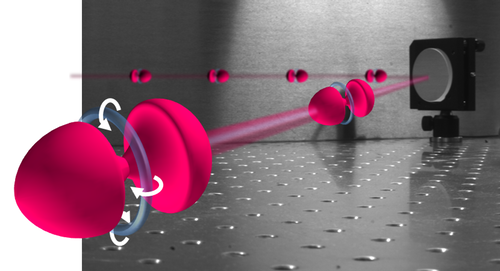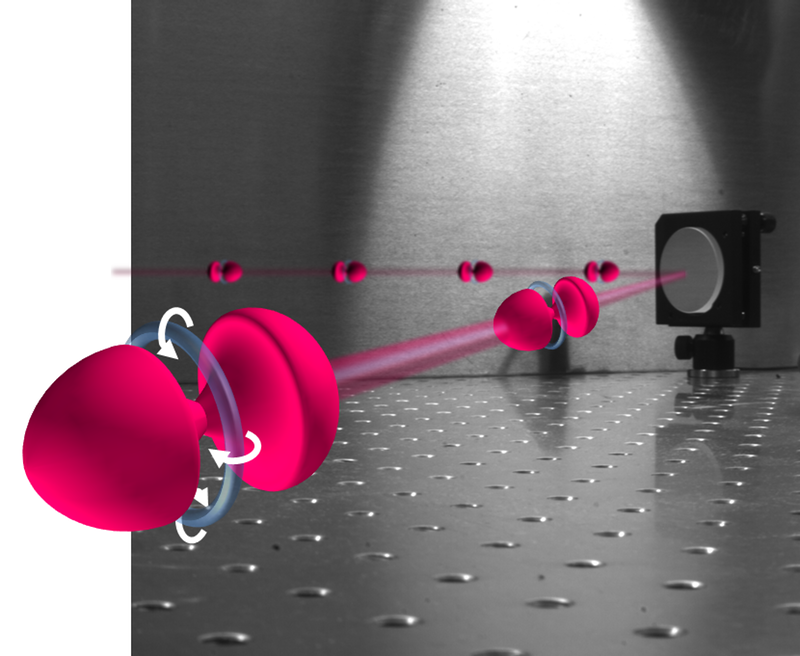Smoke Rings in Light
In a typical optical vortex, light waves twist around a dark line, or hole, through the center of a light beam. Researchers have now uncovered an entirely different type of optical vortex that forms a ring, or toroid, around a self-focusing light pulse. Light waves curl around the vortex, like the air currents around a smoke ring. These so-called spatiotemporal optical vortices (STOVs) are a new optical phenomenon that may be useful in areas such as microscopy or the optical transmission of information.
The rotation around an optical vortex does not concern the direction of the oscillating electric field (polarization), but rather its phase [1]. For example, the maximum of the field might initially be located just above the central axis of a light beam, and then a short time later it’s to the right of the axis, then below. This rotating phase gives the light an orbital angular momentum that can cause a charged particle within the beam to rotate.
Until now, all observed optical vortices have involved rotation in a plane perpendicular to the propagation direction of the light. Now Howard Milchberg and his colleagues from the University of Maryland in College Park have found a unique phase rotation (a STOV) that occurs around a ring propagating along with the light. Vortex rings are common in fluid dynamics and acoustics, but they’ve never been seen in optics. Milchberg’s team discovered the STOVs while studying optical filaments, which are intense pulses of light that alter the medium through which they travel—such as air—in a way that focuses the light into a narrower packet. The team developed computer simulations and found that optical vortices form around pulses just as the self-focusing effect approaches its maximum level. Several STOVs can form at the same time, but only one appears to survive. “It’s like a smoke ring moving at the speed of light,” Milchberg says.
To check the simulations, Milchberg’s group performed a set of experiments with femtosecond laser pulses. The power in each pulse reached several gigawatts, enough to induce self-focusing in air. In order to image the pulses during this self-focusing process, the team placed a helium-filled cell in the beam path. Because helium has a smaller self-focusing effect than air, pulses stopped evolving once they reached the cell. The researchers sent these effectively “frozen” pulses to an interferometer where they were combined with a reference beam. The data provided cross-sectional maps showing the evolution of the intensity and phase of the pulse. These maps showed a dark ring with a diameter of 400 micrometers encircling the central region of the pulse and surrounded by light, just as predicted in the simulations.
The researchers describe the vortex formation with a simplified model in which the central core of a self-focusing pulse is distinct from the periphery. As self-focusing increases, the phase inside the core shifts relative to the phase in the periphery. When this shift reaches 180° (with, for example, core electric fields reaching their maximum in one direction just as periphery fields reach a maximum in the opposite direction), a vortex ring forms at the core-periphery boundary to deal with this phase discontinuity. A similar mechanism produces whirlpools in river streams where fast and slow currents meet.
The STOV discovery provides a unifying picture of the dynamics within a self-focusing pulse. The one surviving STOV has a rotation that channels energy from the periphery to the core at the front of the pulse (and away from the core at the rear). This energy transfer produces the high-concentration of light in the center of a self-focusing pulse, and it explains the de-focusing of light at the back end of the pulse due to ionization of air molecules. So these vortex structures have likely been present in self-focusing and other experiments for decades.
Milchberg says that even lower-intensity, non-self-focusing pulses ought to be capable of producing STOVs, so they may have practical uses in optical communications. His team is currently trying to produce “artificial” STOVs that could serve as bits in a data stream.
Despite being originally surprised by STOVs, Thomas Pertsch of Friedrich Schiller University in Jena, Germany, says that “after reading the paper, one has the feeling that yes, this phenomenon is quite normal and must occur in many situations.” For example, Pertsch believes STOVs should appear in less-intense pulses passing through plates that rotate polarization. He imagines this effect might become useful in high-resolution microscopy.
This research is published in Physical Review X.
–Michael Schirber
Michael Schirber is a Corresponding Editor for Physics Magazine based in Lyon, France.
References
- J. F. Nye and M. V. Berry, “Dislocations in Wave Trains,” Proc. R. Soc. London A 336, 165 (1974).
More Information
Second video on authors' web site similar to the one above but zoomed in on the left half, 0–80 fs
Synopsis: Adding Quantum Rooms to the Hilbert Hotel
Viewpoint: Generation of light bullets





